By KATIE EUBANKS
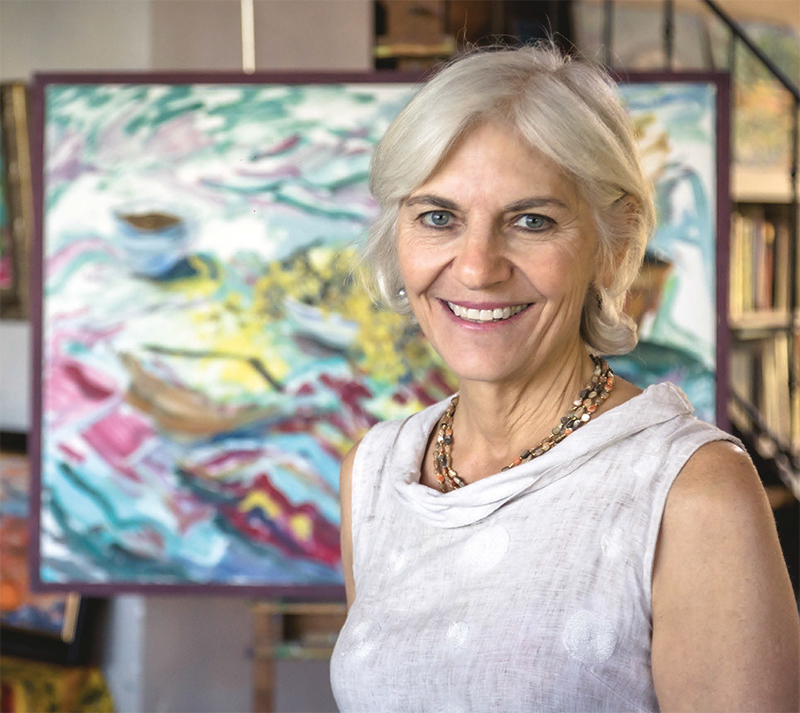
Atlanta native Jill Steenhuis has lived and worked in Provence as a full-time artist for 40 years. She’ll be in Jackson this month to sell her work and hold workshops and demonstrations.
Tasting the eternal
How this Southern-born artist found her calling in the south of France
Jill Steenhuis didn’t know if she had any artistic talent.
She didn’t know if she’d ever get to visit
Paul Cézanne’s studio in the south of France.
She certainly didn’t know she’d fall in love with a Frenchman, work full time as an Impressionist painter, and raise three boys, all in Provence.
For 40 years now, Jill has been living what appears to be a fairytale. She has not only visited Cézanne’s studio, but painted there herself. She does leave France, but mainly to sell her paintings at events benefiting nonprofits in America and Australia. This month, the Atlanta native is coming to Mississippi for several events with the Garden Club of Jackson.
“My whole life was served forth on a silver platter like destiny,” Jill says via Zoom from her home studio in Aix-en-Provence.
Much like Jill’s faith-filled paintings, there’s more to that statement than meets the eye.
‘I will pour water on the thirsty ground.’
When Jill was 8 years old, her mother took her to visit Camp DeSoto for Girls, on Lookout Mountain in Alabama.
Barely half a year later, Jill’s mother committed suicide.
“After my mother died, I told everybody, ‘I’m allergic to’ (whatever they put in front of me). I didn’t eat,” Jill recalls. “I think I was angry inside.”
She also started fibbing, and cussing “when I played tetherball,” she says, now able to look back on her playground persona and laugh.
The following year, her father — now raising Jill and her three younger sisters alone — sent Jill and one sister to Camp DeSoto.
“They said, ‘We’re square at this camp, and you have to learn these rules and abide by these rules.’ I was like, bring on the rules. I didn’t have any rules at home. My father didn’t even know what ‘grounded’ was,” Jill says.
“I wasn’t happy with myself.”

“Flowering Almond Tree at l’Abeille”
Jill had attended church in Atlanta, “but it wasn’t the same as at camp, where you walk with God every day,” she says.
Camp staff encouraged the girls to read from the gospels every day at rest hour, and to remember that God is always present, even on the walk from the dining hall back to their cabins.
“I started thinking about that, and I really did feel His presence. I learned at a young age what faith is. ‘Faith is the substance of things hoped for, and the evidence of things not seen.’ Hebrews 11:1,” she quotes.
“So I would say (my conversion) happened at camp. I was starving when I got to camp. And I was starving again at 10 (years old) the next year, and the next year.
“If I had had (both) my mother and my father, I would not have been starving. (The book of Isaiah says) ‘I will pour water on the thirsty ground.’”
Because Jill’s mother had gone to Camp DeSoto in the ’40s, “I just felt like my mother was there. And it was nurturing. All of the love, and the dancing in the gym, and the views off the brow, and the camaraderie.
“I was a tomboy. I was never a great scholarly child. I grew up fox hunting with my father,” Jill says.
She also grew up skiing in Vail, Colorado, and coming home to an 11-bedroom house with 14-foot ceilings.
Later, there would come a time when that house couldn’t be heated.
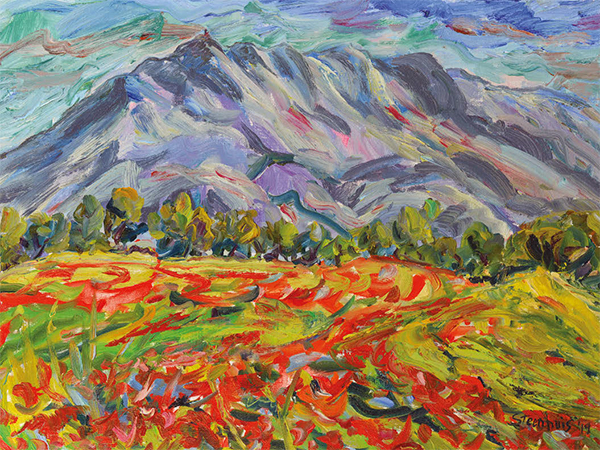
One of Jill’s many paintings of the French Mont Sainte Victoire, a landmark overlooking Aix-en-Provence that was also painted by her artistic hero Paul Cézanne.
A golden ticket
Jill’s favorite activity at Camp DeSoto was crafts. Her father prodded her on in her artistic endeavors, she says. On vacations, “my dad would say, ‘Jill, get out your things and draw,’ while he read the paper.”
Regardless of all that, when she turned 16, Jill didn’t want an easel for her birthday. She wanted a car.
“I was hoping that my father, not having a wife to tell him what to do, would know,” she recalls. “So I walked to the driveway and looked for the four-wheeled gift, and it wasn’t there.
“(But) he was so proud (of what he’d gotten me). I saw it was a book of Paul Cézanne’s paintings. In order not to hurt his feelings, I looked at the book with him. … all of a sudden there were these paintings of mountains, this mountain Mont Sainte-Victoire that’s here (in Provence).
“It was just this act of destiny that brought everything together.”
Still, as a freshman at Sweet Briar College in Virginia, Jill didn’t know what to major in. She took art courses, “but I thought it couldn’t be possible to major in art because I wasn’t any good,” she says. “But my (art) teachers encouraged me.”
When she finally told her father, “Daddy, I’m majoring in art,” she thought he wouldn’t allow it. By that time, he had gone bankrupt.
“(There was a) recession all over the nation. His boat sunk,” Jill says. “But I had my faith.”
Her father, disillusioned with the business world, told her to pursue her passion.
“He said, ‘Jill, look at this book of Sotheby’s (auction items). They’re selling these paintings for (very high prices). Go for it!’”
When she graduated, her dream was to visit the south of France, see Mont Sainte-Victoire in person, and “get to know (Cézanne) better,” she says.
Unbeknownst to her, her father had “scraped together what funds he could,” she says. “To my astonishment, at my graduation (he) gave me a ticket to go to the south of France.”
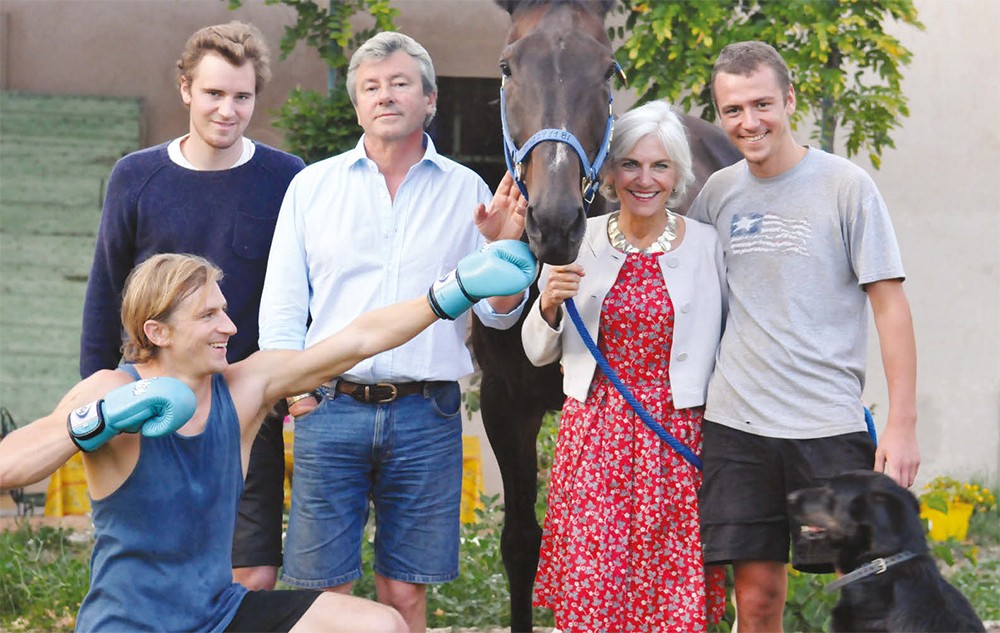
Jill and her family. From left, Alexander (in boxing gloves), Jimmy (James) Ruffato, Serge Ruffato, horse Danilo, Jill Steenhuis, Sergio Ruffato, and dog Laska.
Bilingual romance and $500 a month
When Jill arrived in France on June 16, 1980, to attend the Marchutz School of Fine Arts, she couldn’t speak French.
On her third day there, she met a handsome French guy who couldn’t speak English.
Jill’s sister Lee was also there, taking French classes. The two women went jogging around 9 p.m. — something French women never did — in order to burn off some pastries and croissants.
As they were jogging, two men in a vehicle stopped to ask (in French) for directions to the nearest village. Jill and her sister thought maybe the men were looking for a garden.
A garden would be a nice place to jog.
So the two women got into the car.
Fortunately, the men did nothing more than take them to a café, where more calories were consumed. That evening led to a double date, followed by a single date on the beach for Jill and her beau, Serge.
“I was bilingual in two months,” she says.
Meanwhile, she learned the language of creativity at the Marchutz School.
“I’m so glad I learned (technique) first (at Sweet Briar). Because then the beautiful part of the creative way, I learned at the Marchutz School,” she says.
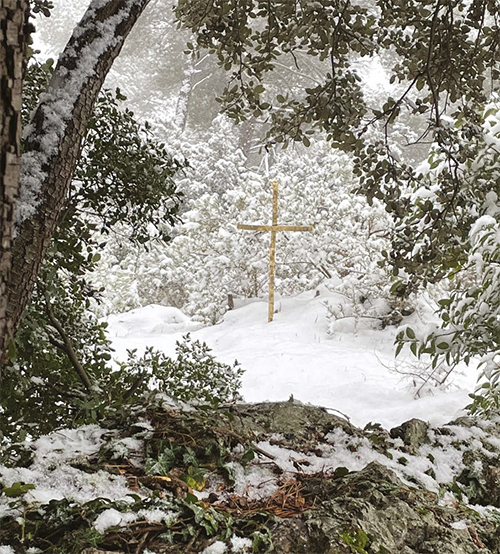
Jill’s meditation spot. “I find that painting is a way to be silent and practice contemplation (too),” she says.
“They said that Cézanne said if you have 90 percent talent and only 10 percent discipline … you will go nowhere. If you have 90 percent discipline and 10 percent talent, even if you have no talent, you can be hanging in the Louvre.”
She didn’t know if she had talent. But she knew she had “determination, will, drive, passion for my art, and for nature and for God,” she says. At the Marchutz School, she learned to put those passions to work.
“That’s what they taught me, was the discipline to paint every day. That was monumental.”
So everything was going great. She was growing artistically, and she’d met the man of her dreams (to whom she is still married, “40 years and three sons later,” she says). There was just one little problem: She had no income from the sale of her paintings.
When she begged her father to let her stay for Marchutz’ yearlong program, which was the equivalent of a master’s degree at the time, he said, “If you can learn to live modestly and paint extravagantly, you can stay.”
So she managed to live on $500 a month. That included rent, food and art supplies. She walked everywhere in order to save money.
She also got to paint at Chateau Noir, where Cézanne had lived and painted for 30 years. Marchutz School founder Leo Marchutz had his studio there for 25 years before he died, and the chateau owners rented the 11 studio spaces to artists. Jill had her studio there from 1981 to 1995.
“It was just amazing to be there and to be able to paint exactly where Cézanne had lived and painted,” Jill says.
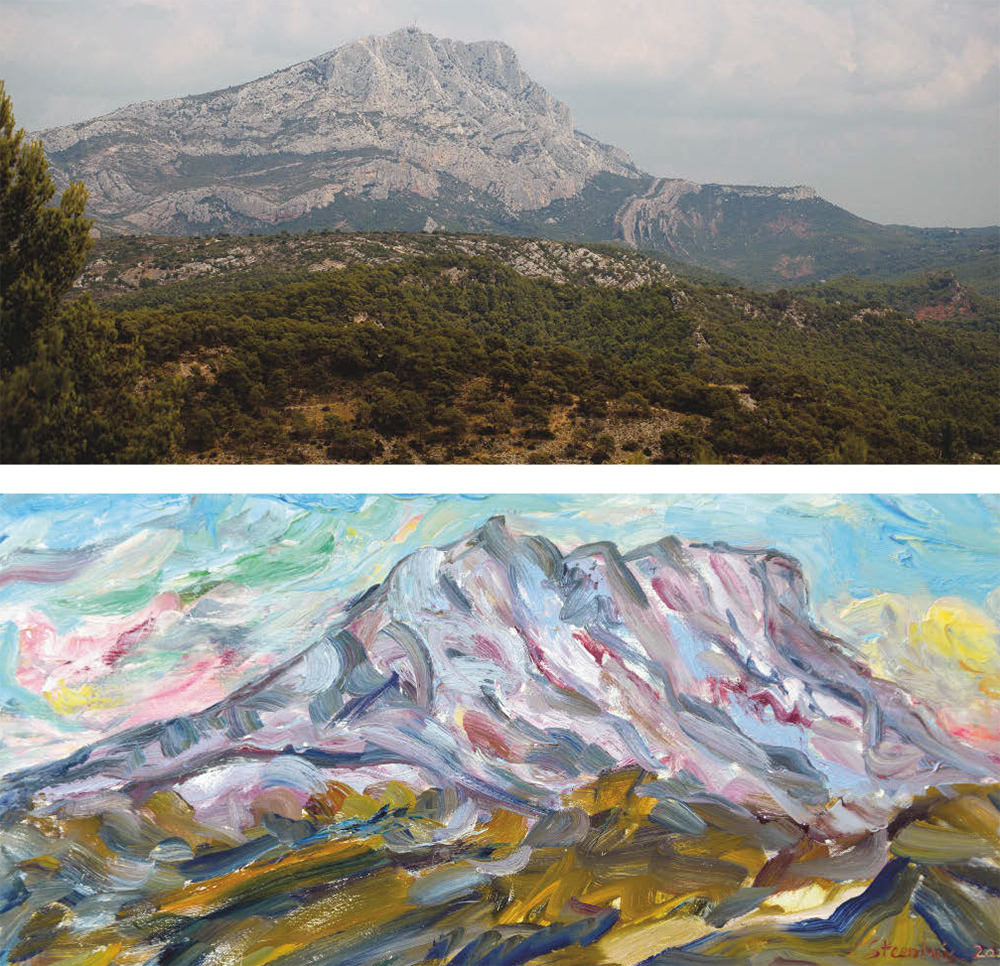
Mont Sainte-Victoire in a photograph (top) and in another of Jill’s paintings.
Playing Jekyll and Hyde
In 1985, Jill turned a corner.
“I had my first art show in Atlanta,” she says, “and I sold 24 paintings, so it gave me $6,000. So it was like, this made a year’s worth of income! So I was on a roll.”
Since then, she has lived on the income of her art. She rarely shows her work in galleries, but travels every six months for art shows benefiting nonprofits. In Jackson, she’s done shows for Stewpot, the Boys and Girls Club, Peyton’s House, and Make-A-Wish.
“It’s been so rewarding to me to work that way …. I’ve made some deep friendships,” she says. “Everything I do, painting the painting and selling the painting, has meaning for me. I just feel I don’t want to do anything that doesn’t have meaning.”
The travel hasn’t always been easy.
“(In the early days) it was wrenching, to leave my toddlers for five weeks, before the Internet, before cell phones, to put a quarter in a phone and say, ‘I’m in Oklahoma City … ’” Fortunately, all three of her sons are grown now.
Switching from artist to art dealer, or “Jekyll to Hyde,” as she says, isn’t quite as tough. She’s enjoyed living her creative life in France, and her business life in America — though the artist shows up here, too.
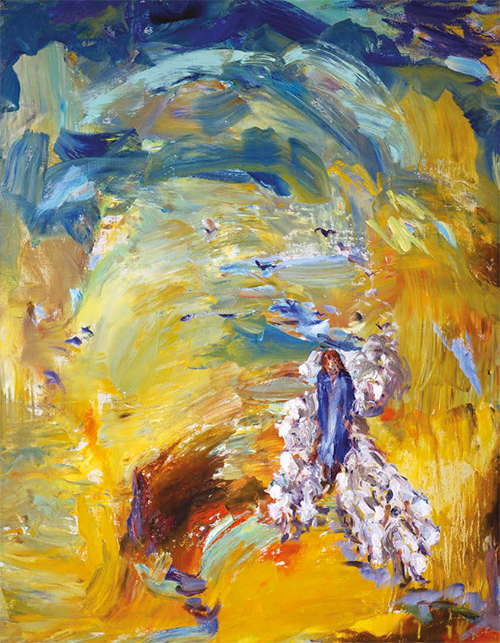
Jill’s “Keeping Watch Over His Sheep”
Some of Jill’s upcoming events at the Mississippi Museum of Art include demonstrations by the artist herself. A word to the wise: Don’t be late.
“Twenty to 45 minutes and the painting is done,” she says.
“But it took me 40 years to get (that fast). So I tell people it takes me 40 years and 45 minutes,” she says, laughing.
“In my workshops, I teach that the way to bypass your intellect is urgency, to paint fast. Because otherwise if you sit there and think about it, the intellect comes and takes the reins.”
For Jill, painting is more of a prayer than a project. “I find that painting is a way to be silent and practice contemplation … in an action way,” she says. “And during that time, I have to practice self-abandonment and receive. (The result is) greater than what I would’ve created with my intellect.
“If you are open to receiving grace during that prayer time of creating that painting, celebrating nature, celebrating that creation that the Creator gave us … Cézanne said art exists to make one taste the eternal.”
That being said, “the modern viewer doesn’t want you to state it all,” she says. “That’s why I like Impressionism.”
Despite being a Christian artist, Jill isn’t “as keen on painting a portrait of Christ,” she says. Instead, she trusts the viewer to fill in the gaps when looking at her work — whether it depicts the good Samaritan, a shepherd (the Good Shepherd?), or a wisteria bush.
“If I didn’t have faith in the viewer, I would paint (every detail),” she says.
Instead, she gives us a taste of the eternal. It’s up to us to imagine the full feast.
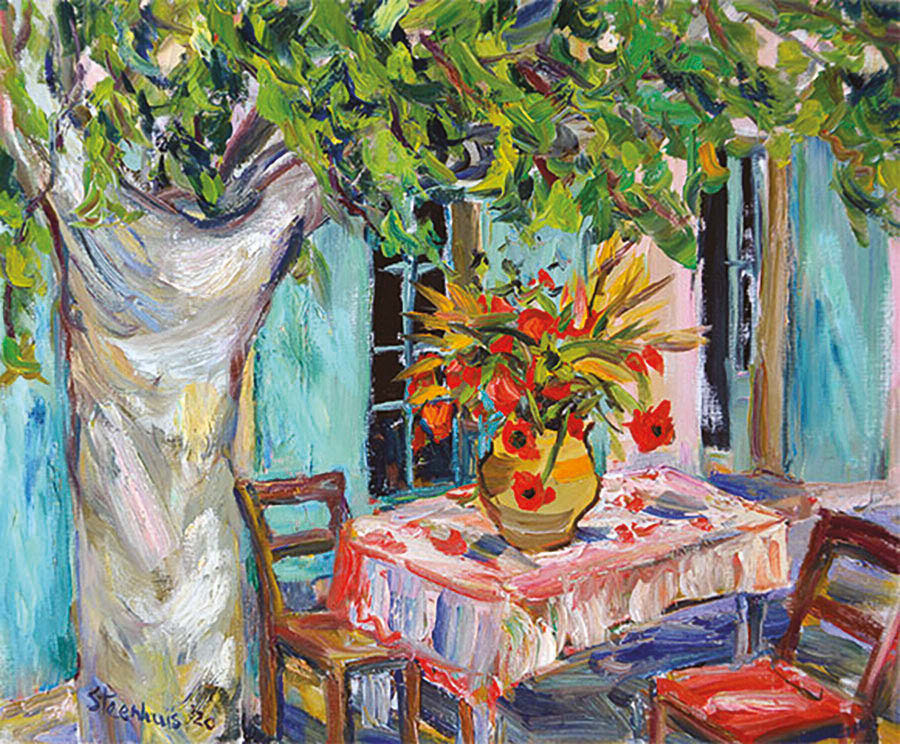
Come Bloom! with Jill
Jill will be in Jackson for a week as part of the Garden Club of Jackson’s “Art, Soul and Bloom!” fundraiser, which will help transform The Mississippi Museum of Art’s Payton City Garden into a landscaped Alyne Payton Cutting and Culinary Garden, a place for the engagement of students and visitors alike. Events are at the Mississippi Museum of Art except where noted.
Art, Soul & Bloom! Events
6–7:30 p.m. Monday, April 12 — Preview & Toast
View and purchase Jill’s paintings, scarves, book and calendar, as well as sculptures and jewelry designed by her middle son, Sergio Ruffato. “(His artwork) really does pair with mine,” Jill says.
Also, the GCJ Member Showcase will feature floral designs, photography, botanical arts and needle arts, all created by GCJ members and inspired by Jill’s paintings and Provence.
6:30–8 p.m. Tuesday, April 13 — Sunset Plein Air Demonstration
Jill’s painting from this event will be available in a silent auction.
9:30–11 a.m. Wednesday, April 14 — Feature Presentation Event
Hear Jill share her story of growing up in Atlanta and finding her destiny in Provence.
6:30–8:30 p.m. Wednesday, April 14 — Film Screening: ‘Painting the Invisible’
Jill’s younger son, James Ruffato, will show the documentary he made about his mother, and answer questions afterward. Jill will also perform a live still-life painting demonstration. A portion of the proceeds from this night will go to Camp DeSoto for Girls.
Workshops with Jill
9 a.m.–5 p.m. Saturday, April 10, and Sunday, April 11 — Oil painting workshop in Gloria Walker’s gardens
“It should be called an art and faith workshop, because I do readings from the monk Thomas Merton, Flannery O’Connor, every day I do readings to get (participants) in the right mindset, to get them out of their to-do list and get into the creative mind,” Jill says.
“And I teach them about mixing colors on a palette and to delete the intellect and let go. So the whole workshop is about letting go.”
2–5 p.m. Monday, April 12 — Drawing workshop
Bring a pencil and drawing pad, and get creative!
2–5 p.m. Tuesday, April 13, or Wednesday, April 14 — Pastel workshop
“My focus is color and the true creative process of taking in nature through the senses to activate one’s unique inner poetry,” Jill says.
9 a.m.–5 p.m. Thursday, April 15, and Friday, April 16 — Oil painting workshop in Katie Breese’s gardens
All workshops are open to beginners as well as artists of all levels. “I’m much more about the experience of creating (than the result),” Jill says. “I used to love fishing as a little girl. You have a wonderful time, whether you catch a fish or not.”
GCJ event tickets are $50 each. Workshop prices vary. Space is limited.
Visit gardenclubofjackson.com/bloom for more info, and visit gardenclubofjackson/bloom-reservations to buy tickets.